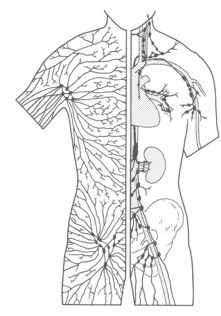Lymphoedema Clinic |
A12
|
 The RUH Lymphoedema Clinc opened in January 2001 and provides specialist inpatient and outpatient care for patients with secondary cancer-related Lymphoedema.
The RUH Lymphoedema Clinc opened in January 2001 and provides specialist inpatient and outpatient care for patients with secondary cancer-related Lymphoedema.
There is no service at the RUH for patients with primary and non cancer related secondary Lymphoedema. However telephone advice and staff education can be provided by the RUH service.
Lymphoedema is a chronic progressive condition caused by the excess accumulation of fluid in the tissues due to inadequate lymphatic drainage.
Lymph is a colourless fluid which forms in the body tissues. It normally drains back into the blood circulation through a network of vessels and nodes. Lymph nodes act as filter stations and they play an important part in the body’s defences.
If the drainage routes through the lymphatic system become blocked or damaged, lymph accumulates in the tissues and swelling (oedema) occurs.
Lymphoedema can occur anywhere in the body but most commonly affects the limb(s).
Diagnosis must differentiate Lymphoedema from oedema caused by heart failure, venous insufficiency, renal failure, hypoalbumineria, and immobility.
Unlike other oedemas, Lymphoedema can lead to changes in the tissues such as fibrosis (hardness) and an increased risk of infection. As well as swelling, Lymphoedema causes decreased mobility, functional difficulties, pain and psychological distress.

